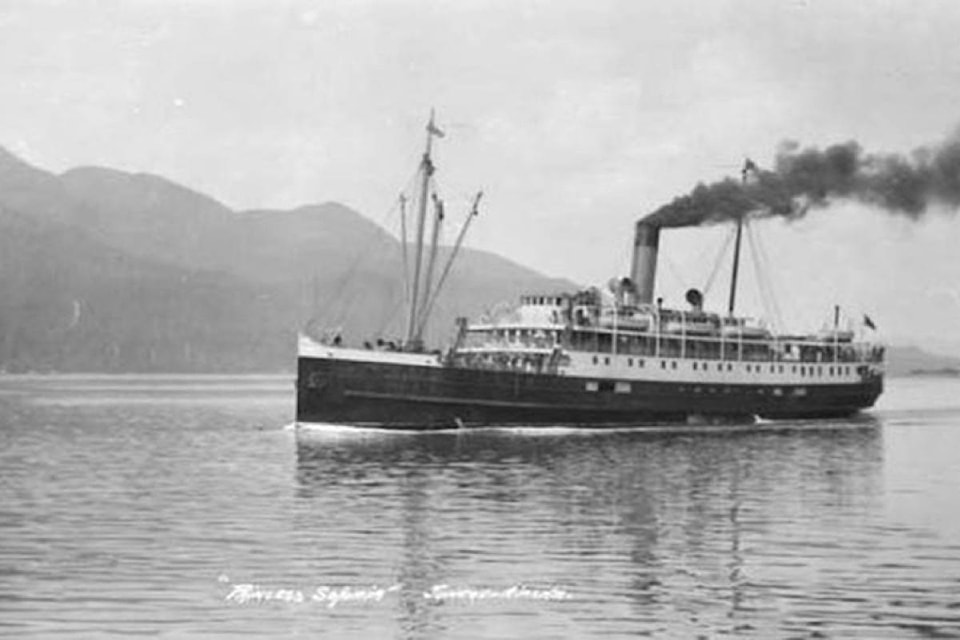Many bodies of women and children were found on life rafts, indicating that an attempt had been made to save them first; they died of exhaustion and exposure.
The Maritime Museum of B.C. is marking the 100th anniversary of British Columbia’s worst marine disaster, the sinking of the CPR’s S.S. Princess Sophia, Oct. 24, 1918.
Last week I told you how she grounded on Vanderbilt Reef in Alaska’s Lynn Canal. There she perched, Capt. F.L. Locke and company officials sure that she’d float free with the next high tide. Failing that, the 343 passengers and crew would be evacuated by the smaller vessels that were already standing by and more on the way.
It all ended suddenly with a last wireless message from the Sophia: “Just time to say goodbye. We are foundering.”
When the U.S. lighthouse tender Cedar received Sophia’s message that she was sinking, about 5 o’clock p.m. Thursday (the 24th), she’d radioed back, “We are coming. Save your juice so you can guide us.” But in the storming blackness the little tender was forced to put back and anchor until daylight. At 8:30 the following morning, she radioed Alaska that only the Sophia’s foremast showed above water.
By then the storm had passed and the would-be rescuers were able to walk, at low tide, over Vanderbilt Reef where the Sophia had perched. The rock where the hull had rested was worn smooth “as a silver dollar” by the grinding action of the ship.
Apparently heavy gusts quartering on her stern, which wasn’t held up by the reef, swung her around, the bow acting as an axis. When the bow was blown free, she filled by the head and sank. It all happened quickly and unseen by the vessels standing by.
In the five days before Sophia’s last sailing, more than 800 persons had reached Whitehorse and Skagway en route to the “outside”. They’d been disappointed to find that practically no shipping accommodation was available. However, more than 300 had been able to board the steamer Prince Rupert which had made a special trip north.
As the Prince Rupert slipped from her Skagway dock, the crowd aboard cheered their good fortune. But those standing on the pier, faced with spending the winter there, watched the departure in silence.
How ironic then that they did cheer when informed that the Princess Sophia would make another trip; 258 men, women and children boarded her.
The heartbreaking task of collecting the bodies began under the personal supervision of Alaskan Governor Riggs. At least 25 vessels participated in the recovery operation. The shores lining Lynn Canal were littered with victims. Many bodies of women and children were found on life rafts, indicating that an attempt had been made to save them first. They died of exhaustion and exposure.
It was learned that passengers had refused the opportunity to be taken off before the storm, preferring the warmth and comfort of the ship to the cold and barren shores. In this, the barometer had performed a cruel deception — it had been rising, indicating an improvement in the weather.
Of Princess Sophia’s crew, many of whom had made their homes in Victoria, one escaped. Chief Engineer A. Alexander was on vacation.
One of the more poignant incidents of the wreck concerned 17-year-old Norman Blyth. He’d been hastening south to the Shoal Bay bedside of his mother who was dangerously ill. He’d made repeated attempts to secure transportation home but had been unsuccessful because of the heavy, end-of-season bookings. Aware that his mother might not recover, he’d made a last desperate effort and managed to get a berth as a steward aboard the Sophia.
Victoria joined Skagway, Juneau and Whitehorse in mourning. Then, still numbed by the blow, Victoria received another severe shock. Exactly one week later headlines announced that the city-based fisheries patrol vessel HMCS Galiano had foundered with all hands in heavy seas off the Queen Charlotte Islands (Haida Gwaii). Almost all of the 26 aboard were from Victoria.
On the night of Nov. 11, 1918 — Armistice Day — the CPR steamer Princess Alice returned to Vancouver with the bodies of 137 victims of the Sophia on her decks.
The Maritime Museum’s special exhibit marking the centennial of her sinking runs until March 11. The exhibit “brings together artefacts and archival documents from multiple organizations for the first time since being salvaged from the wreck, to tell the stories of those who lost their lives and the legacies the disaster has left behind.”
